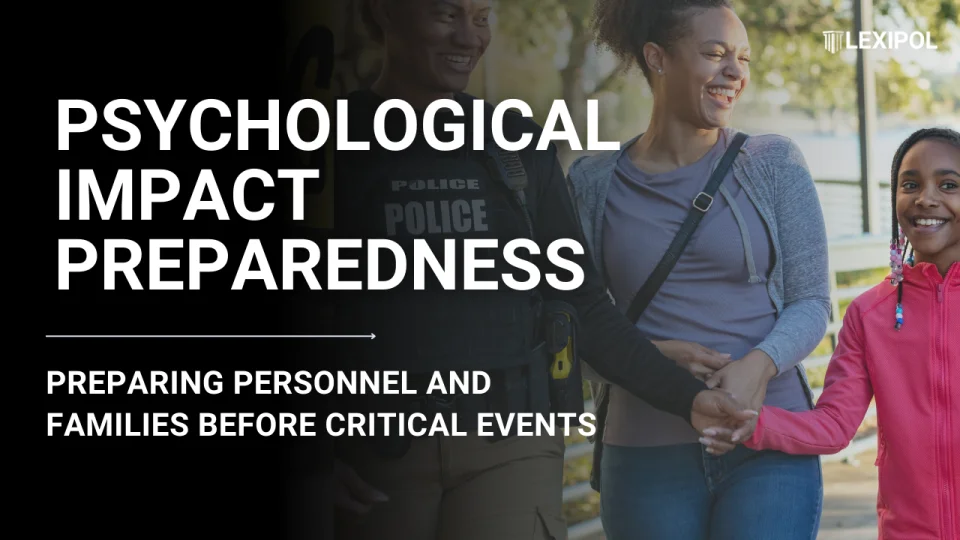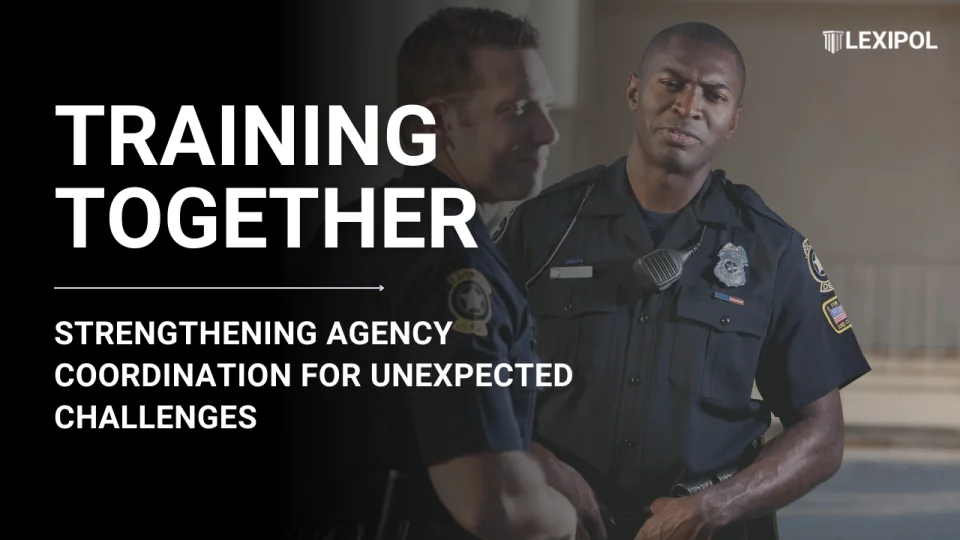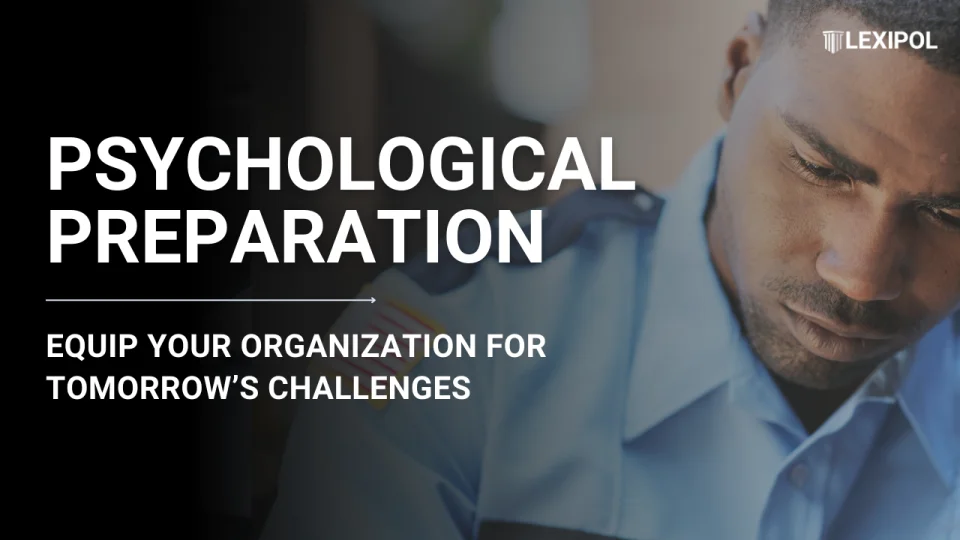Leadership plays a critical role at every stage of civil unrest preparedness — from planning to execution and recovery
As incidents of civil unrest become more frequent and complex, law enforcement agencies face the challenge of adapting strategies to protect both their personnel and the public. Agencies must be prepared to address everything from policy development and interagency coordination to officer wellbeing and post-event analysis.
A recent webinar hosted by Lexipol, “Crisis Command: Civil Unrest Preparedness for Law Enforcement Leaders,” brought together several experts to address this pressing issue. The panel included Dr. Jaime Brower, Vice President of Peer Support and Clinician Training & Certification at Lexipol; Lt. Dik Kushdilian (Ret.), Professional Services Specialist at Lexipol; Chief Booker Hodges of the Bloomington Police Department; and Chief Steven Sund (Ret.), former Capital Police Department Chief in Washington, D.C. The discussion was moderated by Chief Mike Ranalli (Ret.), Lexipol marketing development manager.
Understanding the threat: Civil unrest and its implications
The need for civil unrest preparedness has never been more critical. “Civil unrest can occur unexpectedly, and the consequences of being unprepared can be severe for both the public and law enforcement personnel,” says Dr. Brower. Even when they begin peacefully, events like large-scale protests, political rallies and spontaneous demonstrations can rapidly turn violent. Law enforcement leaders must approach these situations with a robust strategy that balances community safety needs with individual First Amendment rights.
“Predictable is preventable,” says Lt. Dik Kushdilian, using the favorite catchphrase of Lexipol founder Gordon Graham. Kushdilian emphasizes how some events can be anticipated, while also acknowledging the need to have contingency plans for the unexpected.
Kushdilian also underscores the multiple risks associated with protests: “There may be risks to civil or even for civil or even criminal litigation, which has budgetary implications for a department or a city, and, again, reputational harm, to the agency or its leadership.”
Hear about some of the other risks in this short clip featuring Lt. Kushdilian:
One of the primary strategies for managing civil unrest is extensive pre-planning. This encompasses everything from general preparedness to specific actions taken before known or anticipated events. Agencies must adopt clear, consistent policies on how to respond to the various threats their people will likely encounter during a civil disturbance, and personnel must be thoroughly trained on the policies as well as practical techniques and procedures for keeping the peace that maintain order while also ensuring civil rights are respected.
Chief Ranalli highlights the critical need for well-developed mutual aid agreements. These agreements help streamline response efforts by clarifying roles, liability and the command structure ahead of time.
Drawing from his experience, Lt. Kushdilian points out the necessity of identifying high-risk, low-frequency events: “We may not prevent all incidents, but thorough preparation helps mitigate risks to public safety and the department’s reputation.”
Planning should include prepping leadership and sworn personnel, dispatch, and others (including families) who support them. As Dr. Brower says, “You don’t want to be caught off guard as the support network, but that support network also has to be working very diligently ahead of time to ensure that officers and their families are very much so prepared for the psychological impacts that that will and can come.”
Hear more in this short clip:
Chief Hodges emphasizes the importance of interagency training and coordination. “It’s vital that you train with neighboring agencies, even those you don’t typically work with,” he notes, reflecting on his experience managing the Minnesota state response to the Minneapolis riots following the death of George Floyd. Effective coordination ensures that tactics align and empowers different agencies to operate as a cohesive unit.
The reason, Hodges explains, is so “everybody understands what each other’s tactics are and what each other’s capabilities are.”
Learn more from this short clip:
Having consistent command structures is also critical. Incident Command System (ICS) training, which often lacks depth in law enforcement, must be prioritized. “We tend to ‘check the box’ on ICS training,” Hodges warned, “but deploying it in real situations is a different story. The importance of understanding ICS in multi-agency responses cannot be understated.”
Maintaining control amid chaos
Once an event begins, maintaining control is both an operational and psychological challenge. Chief Sund stresses the significance of not only physical readiness but mental preparation. Of primary concern is ensuring each member of your team understands the importance of the First Amendment and why citizens’ rights to free speech and protest must be respected and protected.
“Officers must realize their crucial role in protecting First Amendment activities,” Sund says, adding that personal opinions must not interfere with professional duties during these events.
Going further, Sund highlights the importance of adaptive leadership during times of civil unrest, emphasizing the need for flexibility and real-time decision-making. “Your officers are looking to you for guidance in the heat of the moment, and how you handle yourself will directly impact their actions on the ground,” Sund notes. He urges commanders to be visible and engaged, not just in the command post but alongside their officers: “Walking the line, checking in with your people — it shows them that you are invested in their safety and performance. This simple act of leadership can have a profound calming effect on officers facing extreme stress.” Chief Sund also points out the importance of using real-time intelligence to adjust tactics as situations evolve, ensuring that the response remains proportional and strategic.
The role of media and public perception
One of the key topics brought forward was the media’s role in shaping public perception during civil unrest. As Chief Hodges points out, documenting the event with independent video is essential. “We need to be able to show our side of the story,” he says. Law enforcement often faces criticism based on selective media footage — or selective editing of bystander video — so having agency-controlled footage can help provide a more accurate narrative.
Transparency and communication during these events is essential. By working closely with the media and keeping the public informed about decisions and actions, law enforcement can build trust and potentially de-escalate volatile situations.
Officer wellness: Resilience in the face of adversity
Dr. Brower highlights the psychological toll civil unrest can take on officers. “Responders who are well, respond well,” she says, stressing the importance of psychological resilience. It’s not just about tactical preparation; officers must also be mentally prepared for the emotional strain of being on the front lines of protests or riots.
One major component of this mental preparation is inoculation — helping officers know what to expect before it happens. As Dr. Brower explains, “Giving officers psychological prep — whether it’s techniques to manage stress or educating them on what they’ll hear and see — can make a significant difference in their performance and wellbeing.”
She also emphasizes the importance of peer support and family readiness. While officers are on the front lines, their families often face stress and uncertainty. Agencies should ensure they offer resources not just to officers but to their families as well, providing a comprehensive support system.
Watch this brief clip, in which Dr. Brower explains how important it is to “bulletproof” each team member’s frame of mind in anticipation of a civil disturbance event:
Learning and improving after a civil unrest incident
After an event, agencies must conduct thorough after-action reviews to evaluate what went well and what can be improved. “If your after-action report identifies something you could have done better, take immediate steps to address it,” says Lt. Kushdilian. Even more importantly, he cautions that leaving issues unresolved can lead to reputational damage or legal challenges down the line.
Transparency remains crucial in the aftermath. Chief Sund shares insights from the post-January 6th reviews, emphasizing how agencies should engage with the public and establish (or reestablish) constructive dialogue with local communities to rebuild trust. This includes showing footage of the event when possible and being upfront about what occurred. “Community trust can be severely damaged during these incidents, but by being transparent, law enforcement can regain that trust,” Sund advises.
Final thoughts: The role of leadership in civil unrest preparedness
Leadership plays a critical role at every stage of civil unrest preparedness — from planning to execution and recovery. As the panelists emphasize, leaders must prioritize the wellbeing of their officers, collaborate with other local agencies, and engage with the community to build trust and ensure effective responses.
Chief Ranalli summarizes it well: “Preparedness is not just about having the right tactics, it’s about building resilience in your officers and strengthening relationships with your community before, during and after these events.”
Lexipol’s Content Development staff consists of current and former public safety professionals including lawyers and others who have served as chief, deputy chief, captain, lieutenant, sergeant, officer, deputy, jail manager, PREA auditor, prosecutor, agency counsel, civil litigator, writer, subject matter expert instructor within public safety agencies, as well as college and university adjunct professor. Learn more about Lexipol’s public safety solutions.











